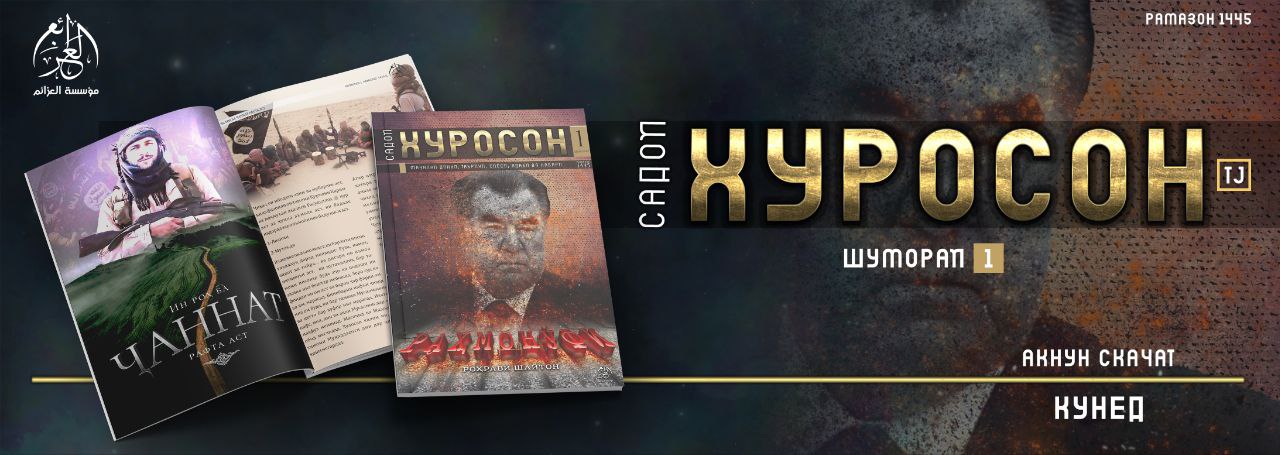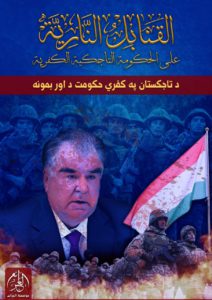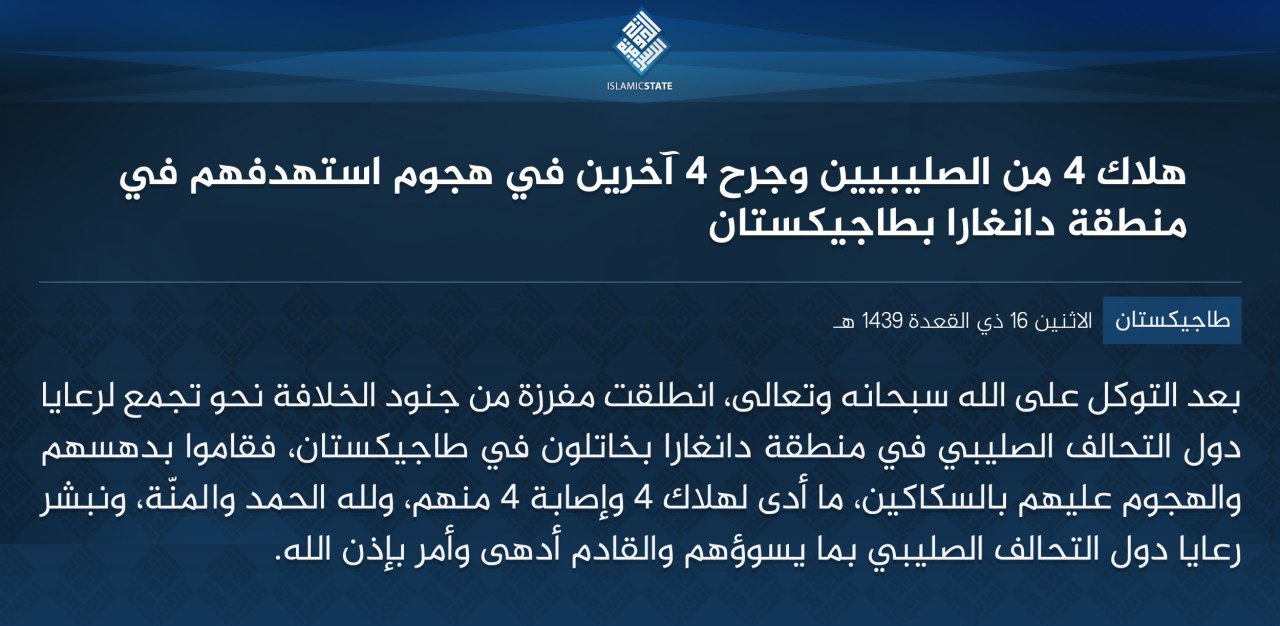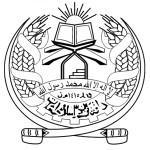The Clear Banner sub-blog on
Jihadology.net is primarily focused on Sunni foreign fighting. It does not have to just be related to the phenomenon in Syria. It can also cover any location that contains Sunni foreign fighters. If you are interested in writing on this subject please email me at azelin [at] jihadology [dot] net.
–
Tajik Fighters in Iraq and Syria
By Edward Lemon
Wreaked by violence in the 1990s, Tajikistan played host to prominent Arab foreign fighters including Ibn Khattab and Abu Walid. Now the situation has reversed and young men are travelling from the mountainous Central Asian republic to fight in Iraq and Syria. Whereas some of the first reported fighters joined Jabhat al-Nusra, now the vast majority have been lured into the ranks of the Islamic State.
With a population of almost eight million, the post-Soviet republic of Tajikistan lies in Central Asia. Ruled by strongman president Emomali Rahmon since 1992, the government defeated an opposition it labelled as “Islamist” in the country’s civil war. Remittances sent by more than a million migrants in Russia form the backbone of the economy, with narcotics smuggling from Afghanistan also playing a key role. Although the majority of the population are Muslim, a seventy year Soviet-led campaign against religion has rendered understandings of Islam as secular; Islam is a key part of national identity but does not correspond to a defined set of beliefs and practices.
Continuing in the footsteps of its predecessor, the Tajik government has promoted a good, national religion, and restricted bad, foreign forms of Islam. Salafism was banned in 2009, studying in foreign madrassas without a permit was criminalised in 2011, and imams were given a list of approved sermon topics in 2012. Tajiks who have joined the Islamic State are reacting to this assertive state secularism back home.
=&0=&
A great deal of scaremongering surrounds the foreign fighter problem in Central Asia. Russian experts, eyeing a return to the Afghan-Tajik border, which it left in 2005, have been keen to highlight the imminent threat that the Islamic State poses to the region. Yevgeny Satanovsky, president of the Russian Institute for Middle East Studies,
stated in September that “the catastrophic wave of violence at the hands of the Islamic State will repeat itself in Afghanistan and then move on to Central Asia.” According to Satanovsky, as many as five thousand Central Asian nationals have uprooted for Syria and Iraq. In late October, Rafal Rohozynsky – identified as a Canadian terrorism expert –
told a conference in Astana that four thousand Central Asians are fighting with the Islamic State. He claimed he derived the figure from a “careful” reading of online material. His comments were widely circulated by Russian language news services.
International news agencies have been even more arbitrary in guessing the number of Tajik foreign fighters in Syria and Iraq. In September, a CNN
map did not mention Central Asian fighters at all. The next month, the Washington Post published a
map stating that thirty Kyrgyz fighters were in Syria; it ignored all the other Central Asian republics.
Ever eager to appear in control, the Tajik government itself has offered more circumspect figures. Addressing officials in September 2014, President Emomali Rahmon said that two hundred Tajik nationals are fighting in Syria. This figure conflicts with the State Committee on National Security’s estimate of three hundred. Interior Minister Ramazon Rahimzoda announced in October that fifty Tajiks have been killed in Syria, though only eleven of these deaths have been reported. Online evidence for sixty five fighters exists. This figure includes twenty fighters from the village of Chorqishloq in the north of Tajikistan. Of these, eleven have been reported killed and a further twenty arrested. The fate of the remaining thirty two remains unreported.
=&1=&
All the reported Tajik fighters have been young men; the oldest being 41 and the youngest 23. Most fighters are recruited in Russia. From Russia, like most foreign fighters, Tajik jihadists transit through Turkey to reach Syria. Approximately one million Tajiks currently work in Russia. Migrants are
allegedly more “vulnerable” to radicalisation. They work in low-paid jobs, often experience xenophobia, and endure abuse at the hands of the government. The offer of a steady income and potential glory of becoming
shadid (a martyr) in Syria may be a tempting prospect for some disillusioned young migrants. Although a link between migration and radicalisation seems to exist, this remains an understudied phenomenon. Further study is needed in order to examine the dynamics through which this relationship manifests itself.
Many of the fighters did not express an interest in religion before they left Tajikistan. After a video of Islamic State fighter Akhtam Olimov appeared online in September 2014, his family were in shock. Neighbours commented that he was never particularly pious when growing up. “He never wore a beard” before he went to Russia, his mother told
reporters. After Bobojon Kurbonov was killed in August 2014, his brother told the
media that “Bobodjon was not a religious man, and we do not understand how he was persuaded to go to war.” Like many young Muslims who join extremist groups, the Tajik recruits appear to lack knowledge of the Qu’ran,
Sunnah, Sharia, or
hadith.
The
case of twenty six year old Bakhtiyor Sherov – also known as Abu Akhmad Tajiki – is typical. Born in Kulob in the south of Tajikistan, like many of his countrymen he left for Russia in 2011. After sending money back to his family for a few months, he disappeared. The next thing his family knew he was dead. Sherov was killed fighting with al-Nusra in March 2014.
=&2=&
Recently, users uploaded twenty videos showing Tajiks fighting with the Islamic State to Russian social networking site Odnoklassniki (Classmates). Ranging from scenes of jihadists eating dinner, joking in a public square, and warnings to the Tajik government, the videos shed some light on the lives of foreign fighters in al-Sham. In one video, a man who identifies himself as Abu Umariyon can be seen at the checkpoint on the edge of an Iraqi town. He stops a car and, speaking in broken Arabic, checks that the driver is not carrying contraband cigarettes.
It is clear that the Tajiks have connections with fellow Russian speaking jihadists from the North Caucasus, Russia, and the other Central Asian republics. In September 2014, Iraqi TV showed an
interview with twenty five year old Tajik national Olim Yusuf who had been arrested on the border with Syria. Although he admitted to working for the Islamic State, he said he was only a driver. His interrogation, however, suggested links with fellow Russian speaking fighters. According to Yusuf, “I went to Raqqa, to a town called Sadaashri. We spent 14 days there. The camp was commanded by Umar Shishani [IS Chechen leader]. There were 18 or 20 people there. Some were Arabs and others were Chechens.” In the interview Yusuf claims that he did not participate in the hostilities.
=&3=&
The Tajik government has frequently highlighted the potential threat posed by violent radicalisation. President Rahmon has
referred to IS as “the plague of the new century and a global threat” and warned Tajiks not to underestimate the “negative role in Tajikistan” of the militant group. Evidence of the threat posed by returnees has been deployed by the regime. In October 2014 the government foiled a terrorist plot to blow up two major tunnels in the north of the country; the group, it claimed, had links with Syria. In response to the foreign fighter problem, Tajik legislators amended to Criminal Code in May 2014 so that it now covers fighting abroad; those found guilty will be jailed for twenty years. The country’s clerical council has also issued a fatwa against travelling abroad to fight, calling it a “great sin.”
Although the government has frequently announced that it will amnesty any fighters who return and even paraded one reformed “
returnee” on national TV, the evidence on the ground indicates a less tolerant policy. The spectre of the Islamic State has been used to legitimise a crackdown on “foreign” forms of Islam. The first Tajik citizens with links to Syria were imprisoned in December 2013. By the end of 2014, one hundred and sixteen citizens had been arrested on charges of “extremism,” almost twice as many as in previous years. A witch hunt is well and truly under way. The walls of local police offices are covered in the mugshots of suspected “Islamists.”
The government has used purported links to militants fighting in Syria and Iraq in order to discredit its opponents. Bahriddin Muminov was arrested in December 2013 and accused of fighting with al-Nusra. State Television showed interviews with him in which he declared that he was a member of Islamic Renaissance Party, the regions only legal religious party. On 2 May, three Tajiks accused of fighting in Syria
stated that the Turajonzoda brothers, prominent Tajik clerics, sent them to fight against Assad. All of these accusations remain unsubstantiated and appear to be politically motivated.
Government repression of religion in Tajikistan has produced counterproductive results and served to push more citizens into the arms of radical groups. By examining the profiles of Tajik fighters, it emerges that a cocktail of alienation, marginalisation and vulnerability lures them into travelling to Syria and Iraq. Al-Sham also remains an
attractive site for jihad; unlike the more traditional destination of Afghanistan, it is Arabic speaking, the militants are well-polished users of social media, and the Islamic State appears to be winning. As long as this is the case, more militants will travel from mountainous Tajikistan to join the jihad.
Edward Lemon is a PhD candidate at the University of Exeter










